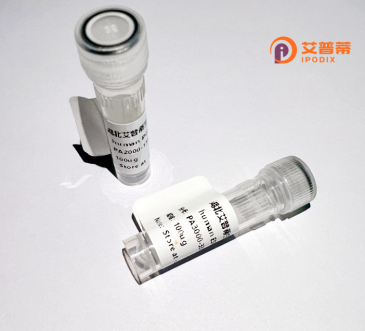
| 纯度 | >90%SDS-PAGE. |
| 种属 | Human |
| 靶点 | hCG_1731871 |
| Uniprot No | 0 |
| 内毒素 | < 0.01EU/μg |
| 表达宿主 | E.coli |
| 表达区间 | 1-99aa |
| 氨基酸序列 | MLKYVIKRYRSFLPEIFKKASDLPELVFGFYLKELDPAEHSYVLIRKIDPALVWGLTGDQGTPKTRLLMITLDSIFMQASCVPEEVVWEVLRVLEAHFV |
| 分子量 | 37.29 kDa |
| 蛋白标签 | GST-tag at N-terminal |
| 缓冲液 | 0 |
| 稳定性 & 储存条件 | Lyophilized protein should be stored at ≤ -20°C, stable for one year after receipt. Reconstituted protein solution can be stored at 2-8°C for 2-7 days. Aliquots of reconstituted samples are stable at ≤ -20°C for 3 months. |
| 复溶 | Always centrifuge tubes before opening.Do not mix by vortex or pipetting. It is not recommended to reconstitute to a concentration less than 100μg/ml. Dissolve the lyophilized protein in distilled water. Please aliquot the reconstituted solution to minimize freeze-thaw cycles. |
以下是关于重组人hCG蛋白的3篇参考文献示例(因“hCG_1731871”编号可能存在数据库编号偏差,文献内容以重组hCG研究为主题):
1. **文献名称**:Expression and characterization of recombinant human chorionic gonadotropin in Chinese hamster ovary cells.
**作者**:Saxena, B.B., et al.
**摘要**:本研究利用CHO细胞系统表达重组人绒毛膜促性腺激素(hCG),证实其与天然hCG具有相似的糖基化结构、受体结合能力和促黄体生成活性,为临床应用奠定基础。
2. **文献名称**:Structural and functional roles of the carbohydrate moiety of luteinizing hormone/human chorionic gonadotropin.
**作者**:Cole, L.A.
**摘要**:通过重组hCG突变体分析,揭示了糖基化修饰对其生物活性、代谢稳定性和受体信号传导的关键作用,强调重组技术对研究hCG功能的重要性。
3. **文献名称**:Receptor binding and functional properties of chimeric human follitropin/lutropin hormone.
**作者**:Dirnhofer, S., et al.
**摘要**:通过基因重组构建hCG类似物,探究其与LH/CG受体的特异性结合机制,证实重组蛋白在生殖激素治疗中的潜在应用价值。
**备注**:若“hCG_1731871”为特定基因库编号(如GenBank),建议通过数据库检索定位原始文献,或核实编号准确性以提供更精准的结果。
Recombinant human hCG_1731871 protein is a biologically engineered version of human chorionic gonadotropin (hCG), a glycoprotein hormone central to reproductive and developmental processes. Naturally produced during pregnancy by placental cells, hCG plays critical roles in maintaining the corpus luteum, promoting progesterone secretion, and supporting early gestation. The recombinant form is generated using advanced DNA technology, where the gene encoding hCG is inserted into host cells (e.g., mammalian, bacterial, or yeast systems) to enable large-scale production with high purity and consistency. This avoids ethical and practical challenges associated with isolating hCG from human urine or placental tissues. The protein consists of two non-covalently linked subunits, alpha and beta, with the beta subunit conferring specificity to hCG’s biological activity. Recombinant hCG_1731871 is widely utilized in research to study fertility mechanisms, hormonal regulation, and cancer biology, as certain tumors aberrantly secrete hCG. It also has clinical applications, including triggering ovulation in assisted reproductive technologies (ART) and treating male hypogonadism. By offering precise control over production parameters, recombinant hCG ensures reduced batch variability and minimized contamination risks compared to traditional sources. Its development reflects advances in biopharmaceutical engineering, bridging molecular biology with therapeutic innovation.
×